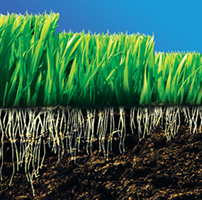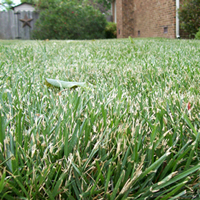Mowing is an integral part of maintaining a healthy lawn, and if done correctly, allows a lawn to grow thicker and fuller throughout the season. Keeping your lawn in the best shape is as easy as following NaturaLawn's best lawn mowing tips.
Mow at the Correct Height
Mowing height is critical. Mowing a lawn too low is one of the most common and detrimental things people do to lawns. When a lawn is consistently mowed too short, the lawn itself compensates by shortening its root system. A shorter root system means the grass will require more frequent watering and fertilization because grass blades with shorter roots can less readily absorb moisture and nutrients. This is why setting your mower blade to the proper height is essential for a healthy lawn.
The proper height to mow your lawn depends on the type of grass you have. Here are recommendations for some of the most common varieties of turfgrass:
- Bluegrass, Ryegrass, Tall Fescue and St. Augustine grass should be cut at 3 inches
- Centipedegrass and Common Bermudagrass at 2 ½ inches
- Zoysiagrass at 2 inches
- Hybrid Bermudagrass at 1 inch
If you're unsure of what type of grass you have in your lawn, send us a photo or ask your local NaturaLawn of America technicians; we'll help you figure it out.
Avoid Cutting on a Set Schedule
In addition to mowing at the correct height, it is also crucial to mow grass when it is needed. Avoid regular mowing just out of habit. In other words, don't mow your grass on a set schedule. In the spring, the heavy growing season, your grass grows fast and may require cutting once every four or five days. A good rule of thumb is to never cut off more than the top third of the grass plant.
The food production process for grass takes place primarily in the plant's leaf tissue. Mowing too low and infrequently, negatively impacts the plant's ability to produce and store food. The result is a plant (and lawn) that is weakened and less tolerant to heat, drought, diseases, insects and traffic.
Read about more common lawn care mistakes you should avoid.
Keep your Mower Blades Sharp
Keeping your mower blades sharp is another central piece to proper mowing practices. Sharpened mower blades—whether you have a push lawn mower or a riding mower—allow for clean cuts to the grass blades. Dull mower blades, on the other hand, rip and shred grass. When a grass plant is cut with a dull blade, it weakens the plant and opens it up to disease and insect attacks. Not to mention, dull blades make turfgrass look frayed, which can be misdiagnosed as a weed or disease.
To easily remember how often to sharpen your mower blade, use the “Holiday Schedule”, which means sharpening your blades around Memorial Day, the 4th of July, Labor Day and Thanksgiving. For more on why a sharp mower blade is important check out our clip tip video on why sharp mower blades are important.
Mow During Ideal Hours
The time you mow is significant. Avoid mowing during the heat of the day when possible (this is hard on the grass and you!). It is better to mow in the evening when it is cooler and the turf is dry. Mowing in the early morning when there is dew on the lawn should also be avoided as this may spread fungus. In short, mowing wet grass generally makes a mess.
Leave Grass Clippings on the Lawn
Do not bag grass clippings after mowing. Bagging your clippings may be tempting cosmetically; however, it’s generally better for your lawn if you leave them. Clippings act as a natural fertilizer for your lawn, feeding the grass as they decompose. The only times clippings should be removed are when the grass has grown too long and creates clumps of clippings, or when there has been a lawn disease.
Avoid Cutting in the Same Pattern
For some, mowing patterns are an art form. While we can't argue that a freshly striped lawn looks gorgeous; cutting the same way every time can be damaging to the turf. Rotating the mowing direction will help the grass to stand up straight as well as prevent wearing patterns and compacted soil.
Proper mowing goes a long way in ensuring a healthy lawn. Many turf problems can be corrected by using proper cultural practices in conjunction with a quality lawn care program. Follow these mowing tips, and you'll be on your way to the best looking lawn on the block!
Follow NaturaLawn’s Best Lawn Mowing Tips for a Lush Lawn
The most efficient way to mow—that is, the mowing regime that will best help your lawn thrive—takes into consideration many factors:
- Mowing height
- How regularly you mow
- The sharpness of mower blades
- What hour of the day you mow
- Whether to leave clippings on the lawn
- The pattern in which you mow
Do you need help sorting out the ideal lawn care recipe for your lawn? Contact the lawn care experts at NaturaLawn of America for seasoned advice.









